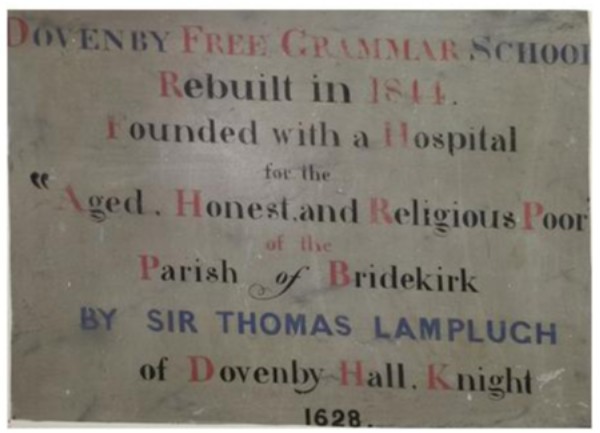-
07540 274737
The Workhouse

In past times, the workhouse was the dreaded destination of the poor of our parish. The reformation had led to the monasteries and other religious houses which had cared for the poor being unavailable.
Ecclesiastical Parishes had responsibility for their poor, but they didn’t want to have to pay to keep other peoples’ poor. As long ago as 1558, an Act of Parliament made provision for beggars and vagrants to be returned to their parish of birth, or to the last parish where they had lived for a year or more, to be cared for there. Surprisingly this measure lasted until World War 1.
There is a plaque on the wall of Bridekirk Dovenby School hall, as shown above, the wording of which is:-
Dovenby Free Grammar School
Rebuilt in 1844
Founded with a Hospital
for the
“Aged. Honest.
and Religious Poor
of the
Parish of Bridekirk
BY SIR THOMAS
LAMPLUGH
of Dovenby Hall.
Knight
1628
The hospital and school was endowed with the tithes of Redmain, in Isel parish. This would have been a common form of care for the needy in historical times, with the rich hopefully seeing it as their duty to attend to those in need in their locality. In fact, there are records of wealthy people in Papcastle, Brigham and other places locally doing the same. The establishment may have been described as a hospital, but would have been simply a place for old people to be cared for, rather than a place dedicated to medical treatments.
The hospital only cared for a very small number of people, and so would not have been a complete solution. It’s interesting to note that the endowment mentioned on the plaque still exists as a registered charity, and in a recent year gave Bridekirk Dovenby School £189.00.
With the development of towns and increase in population, the poor were too numerous for this to tackle the social problems of poverty, and the work couldn’t be left entirely to people like Sir Thomas. The workhouse was one solution – but not really a very pleasant one for the clients. Records of some workhouses mention ‘stone breaking rooms’ to keep the men busy. The Oliver Twist story probably wasn’t far from the truth.
Bridekirk didn’t have its own workhouse. The first Cockermouth workhouse was built in about 1746 on Skinner Street, on the bank of the Tom Rudd Beck. The building survived until the early 1970s.
Cockermouth Poor Law Union formally came into being on 1st December 1838. Its operation was overseen by an elected Board of Guardians, 58 in number, representing its 47 constituent parishes. Bridekirk was one of those parishes.
The Poor Law Union workhouse in Cockermouth was at the top end of Gallowbarrow where the flats are now. The 1923 map of Cockermouth still shows the building.
The building was used by the Home Guard as their base during the war, and was eventually demolished to make way for the flats which the Cockermouth Urban District Council built. Many of the flats are now privately owned.
The workhouse records for 1891 give a clue as to the attitudes of the day, and the way the disadvantaged were likely to be regarded.
There were three blind residents, five idiots, thirteen imbeciles, six lunatics, nine children from two to four years old, four vagrants and 108 people classified as infirm, who were mainly elderly.
The words idiot, imbecile and lunatic actually have dictionary definitions indicating degrees of disability, though today they would be words we would regard as insulting and politically incorrect.
Many of the old people would die in the workhouse, and under the terms of the 1832 Anatomy Act, bodies unclaimed for forty-eight hours could be disposed of by donating them for use in medical research and training.
As you would expect, the former occupations most of the inmates detailed are those belonging to the ‘labouring classes’. If you had family with money you would probably not have ended up in the workhouse, though it was common for previously prosperous business people to end up ‘ruined’ and in the workhouse.
There is no mention in the 1891 records of any inmate born in the parish of Bridekirk, but as many were from the local area, it is likely that some at least had lived in our parish. Many labourers would have moved from one farm or other place of work to another frequently.
You may be surprised to learn that the workhouses were not abolished until 1930, and in many places the premises eventually became hospitals or old peoples’ homes. When I was a child, I was told in the 1950’s of relatives who had lived out their last years in the ‘workhouse’ when in fact they must have been in an NHS hospital, which grew out of a workhouse.
The Local Government Act 1929 was an Act of the Parliament of the United Kingdom that made changes to the Poor Law and local government in England and Wales. The Act abolished the system of poor law unions in England and Wales and their boards of guardians, transferring their powers to local authorities. Under the Act all boards of guardians for poor law unions were abolished, with responsibility for public assistance transferred to Public Assistance Committees of county councils and county boroughs. The local authorities took over infirmaries and fever hospitals, while the workhouses became public assistance institutions. Later legislation was to remove these functions from the control of councils to other public bodies: the National Assistance Board and the National Health Service.
Sometimes, we may yearn for the ‘good old days’, but were they?
There is an interesting article about the Cockermouth workhouse on the Cockermouth Museum Group website which can be read by clicking on the link https://kirkgateartsandheritage.org.uk/wp-content/uploads/2022/03/A-COLLECTION-OF-VARIOUS-ARTICLES.pdf
More information on workhouses in the area can be seen at https://www.workhouses.org.uk/Cockermouth/
Cockermouth workhouse inmates in 1881 are listed at https://www.workhouses.org.uk/Cockermouth/Cockermouth1881.shtml